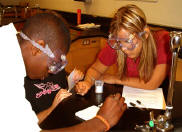A Tradition of Excellence
 Owned and operated by the Archdiocese of Los Angeles and named in honor of Joseph Sadoc Alemany, O.P., Bishop Alemany High School, like the man, has had the “desire to be of service” as its hallmark from the beginning.
Owned and operated by the Archdiocese of Los Angeles and named in honor of Joseph Sadoc Alemany, O.P., Bishop Alemany High School, like the man, has had the “desire to be of service” as its hallmark from the beginning.
Origins: Situated in the shadows of the San Fernando Mission, Bishop Alemany was originally named Saint Ferdinand High School (a parish school for girls established in 1947).
For the purpose of attracting a greater variety of students, His Eminence James Francis Cardinal McIntyre changed not only the name, but also the status of Saint Ferdinand High School by making it co-instructional (i.e., having non-integrated boys and girls sections). In September 1956, the new Bishop Alemany High School opened on the Rinaldi campus (across the street from the Mission complex) with 456 students. It remained co-instructional in nature. Though small in numbers, Alemany had a great spirit that attracted others. By 1959 the student body numbered 1,000. In September 1970, Alemany High School became co-educational with the integration of the boys and girls divisions. During the 1980s and 1990s, Bishop Alemany High School grew in numbers and stature.
Turning Points: The history of Bishop Alemany is filled with examples of a determined spirit triumphing over unfavorable odds. In February 1971 the Sylmar earthquake severely damaged the chapel and other campus structures. With the united support and effort of the Archdiocese and the Alemany community, the school quickly resumed after repairs. Some twenty years later, the powerful January 1994 Northridge earthquake completely destroyed the structures of the Rinaldi campus. Like a phoenix, however, the Alemany spirit remained strong and rose from the disaster.
After the Northridge earthquake, Bishop Alemany High School was relocated across Rinaldi Street to the campus of Our Lady Queen of Angels Seminary. The students shared the beautiful campus with the seminarians for one year. In the summer of 1995 Queen of Angels Seminary closed permanently. Bishop Alemany High School remains, and is once again “situated in the shadows of the Mission”. At its present location, Alemany is the largest school in the Archdiocese of Los Angeles. It is a campus reflecting the beauty of nature, and symbolic of the planting and nurturing of the seed of knowledge occurring in the classrooms.
Over the years several critical events have occurred (e.g., site changes, earthquakes, low enrollment)—any of which could have meant the end of an educational institution. Yet, Bishop Alemany High School has not only survived these adverse events, it has thrived in spite of them! Again, like a phoenix, the school has risen from each challenge renewed and energized. Various cultural groups have elected to attend Bishop Alemany High School, and with the advent of diverse challenges each group has chosen to remain and make the best of the school.
Today, Bishop Alemany High School still attracts a “greater variety of students”, boasting a racially and culturally diverse student body of about 1,600. Like numerous alumni before them, the students strive to continue a proud tradition being of service to the community, being “a people dedicated to service”. The tradition of excellence in education manifests itself in a full honors and Advanced Placement (AP) curriculum, while maintaining strong college-preparatory and standard courses. Bishop Alemany students have been Academic Decathlon Regional Champions from 1996-2002. Students have also placed well in regional speech and debate tournaments. A beautiful Student Activity Center and Gymnasium was completed and occupied in 2001.
 Being of Service: At Bishop Alemany High School we enable students to be an incarnation of our Mission Statement! We focus on enabling students to become: a community—that is, a unified body of individuals with common interests and linked by a common policy with a dedication to service of others; intellectually accomplished persons—that is, people given to study, reflection, and who are engaged in activity requiring the creative use of the intellect; conscientious leaders—leaders who are governed by and conform to the dictates of an informed conscience; morally courageous agents of peace and justice —individuals who do not fear to witnessing to a standard of what is right and good—even when others are witnessing to the contrary… and individuals capable of producing an effect in the interest of peace and justice.
Being of Service: At Bishop Alemany High School we enable students to be an incarnation of our Mission Statement! We focus on enabling students to become: a community—that is, a unified body of individuals with common interests and linked by a common policy with a dedication to service of others; intellectually accomplished persons—that is, people given to study, reflection, and who are engaged in activity requiring the creative use of the intellect; conscientious leaders—leaders who are governed by and conform to the dictates of an informed conscience; morally courageous agents of peace and justice —individuals who do not fear to witnessing to a standard of what is right and good—even when others are witnessing to the contrary… and individuals capable of producing an effect in the interest of peace and justice.
Thus the name of Bishop Alemany will continue to be written large in the history of the Catholic Church in California as we meet and conquer the challenging problems of this most difficult period.
